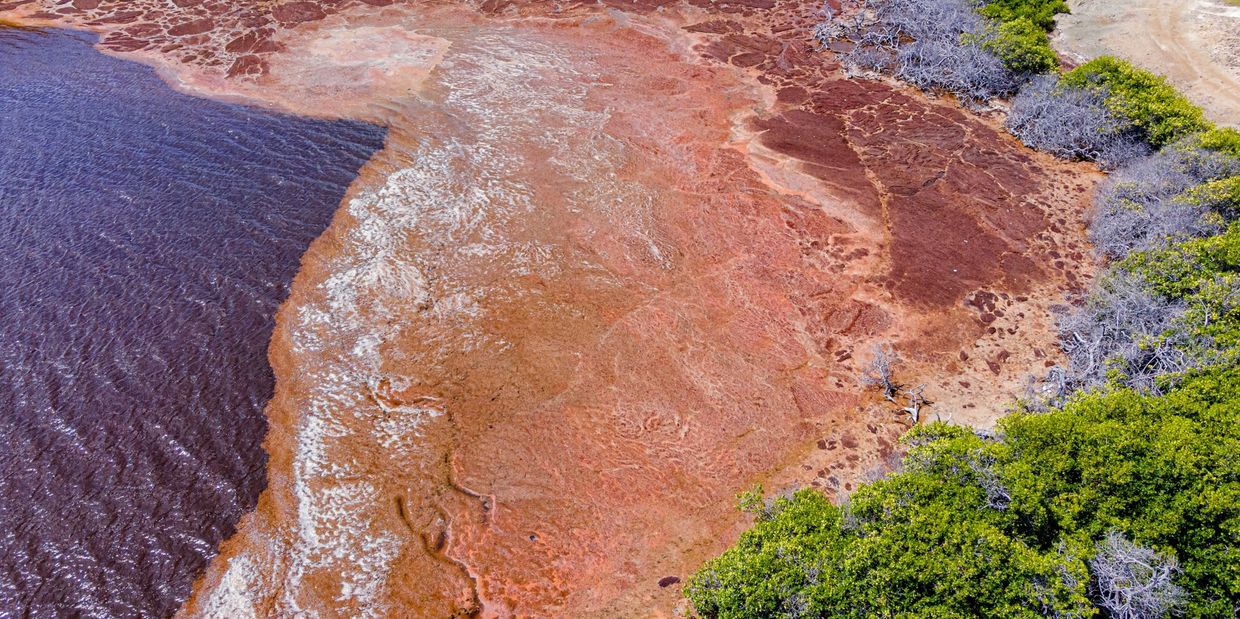
Why Sargassum is a Public Health Issue:
Sargassum seaweed isn’t just a hazard for the oceans. It affects all life, especially when it washes up ashore. Sargassum decomposes on land, releasing hydrogen sulfide - a toxic gas that has a strong, rotten-egg odor - and ammonia. These gases cause significant respiratory problems, particularly for individuals with asthma, bronchitis, and other pre-existing lung conditions.
Short-term exposure to hydrogen sulfide and ammonia can cause symptoms such as:
- Coughing and throat irritation
- Shortness of breath
- Chest tightness
- Eye irritation
- Headaches and dizziness
In severe cases, prolonged exposure to higher concentrations of hydrogen sulfide and ammonia can lead to nausea, vomiting, and even loss of consciousness. Vulnerable populations, such as children, the elderly and pregnant women are particularly at risk. Severe cases of exposure can also cause hypertension disorders for expectant mothers.
Acute Poisoning Outbreaks: In 2018, there were more than 11,000 reported cases of acute sargassum toxicity in Martinique and Guadeloupe, including several intensive care admissions.
Decomposing sargassum also contaminates water sources by harboring toxic substances:
- Bacteria and Pathogens: Studies have shown that Caribbean Sargassum harbors high concentrations of Vibrio bacteria, including pathogenic species; in some cases, Vibrio can make up to 26.8% of the Sargassum microbiome —vastly higher than in surrounding seawater—with beached Sargassum consistently linked to elevated Vibrio abundance and increased public health risks, especially as these bacteria can persist on both the seaweed and plastic debris within the mats.
- Heavy Metals: Sargassum can absorb heavy metals from the water, such as arsenic, mercury, lead, and cadmium. When the seaweed decomposes or is consumed by marine life, these metals can enter the food chain, potentially causing toxic effects in both marine and human populations. These heavy metals also release into soil and water sources when sargassum decomposes, threatening public health.
- Microplastics: Sargassum in the Caribbean acts as a powerful collector and concentrator of microplastics, with microdebris levels averaging 180 times higher than surrounding open water habitats.
Island nations are particularly vulnerable to contaminated fresh water resources. Contact with tainted water has been linked to skin rashes, irritations, and even gastrointestinal issues if the water is consumed.
Selected References:
1. U.S. Environmental Protection Agency, 2025, Sargassum Inundation Events – Impacts on Human Health, https://www.epa.gov/habs/sargassum-inundation-events-sies-impacts-human-health
2. Baylor College of Medicine, 2023, Sargassum seaweed carries potential for respiratory problems, https://www.bcm.edu/news/sargassum-seaweed-carries-potential-for-respiratory-problems
3. Banydeen R, et al., 2024, Sargassum Inundations and the Risk of Hypertension Disorders Among Pregnant Women Living in the French Caribbean Island of Martinique, https://pubmed.ncbi.nlm.nih.gov/35902384/
4. Environmental Health News, 2022, Multiple effects of sargassum on health, https://www.ehn.org/sargassum-health-effects-2659678211.html
5. The Lancet, 2018, Sargassum seaweed on Caribbean islands: an international public health concern, https://www.thelancet.com/journals/lancet/article/PIIS0140-6736(18)32777-6/fulltext
6. Michotey et al., 2020, In situ observations and modelling revealed environmental factors favouring occurrence of Vibrio in microbiome of the pelagic Sargassum responsible for strandings, https://hal.science/hal-02933822v1/document
7. National Science Foundation, 2023, Perfect 'pathogen' storm: Vibrio bacteria, Sargassum and plastic marine debris, https://www.nsf.gov/news/perfect-pathogen-storm-vibrio-bacteria-sargassum
8. Rodriguez-Martinez et al., 2020, Element concentrations in pelagic Sargassum along the Mexican Caribbean coast in 2018-2019, https://pubmed.ncbi.nlm.nih.gov/32149030/
9. Mexico News Daily, 2022, Experts warn of danger to health posed by rotting sargassum, https://mexiconewsdaily.com/news/experts-warn-of-danger-of-rotting-sargassum/
10. Desiere et al., 2018, Sargassum seaweed on Caribbean islands: an international public health concern, https://www.thelancet.com/journals/lancet/article/PIIS0140-6736(18)32777-6/fulltext
11. Desiere et al., 2023, Sargassum seaweed in the Caribbean: A major public health problem still unsolved, https://pmc.ncbi.nlm.nih.gov/articles/PMC10024476/
12. Resiere, Dabor, et al., 2021, Sargassum seaweed health menace in the Caribbean: clinical characteristics of a population exposed to hydrogen sulfide during the 2018 massive stranding, Clinical Toxicology 59.3 (2021): 215-223.
This website uses cookies.
We use cookies to analyze website traffic and optimize your website experience. By accepting our use of cookies, your data will be aggregated with all other user data.